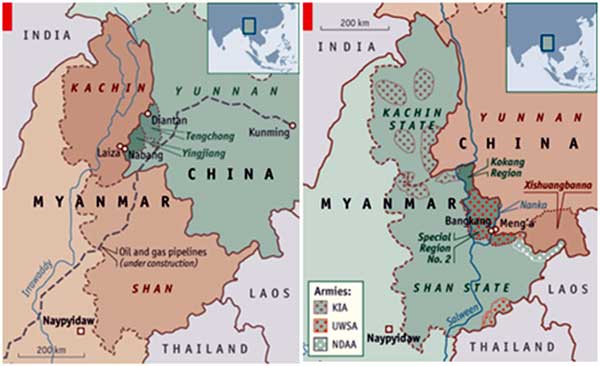Myanmar President U Htin Kyaw paid a state visit to China from April 6-11, 2017 at the invitation of Chinese President Xi Jingping. During the visit, President U Htin Kyaw held bilateral talks with President Xi Jinping and met Premier Li Keqiang and National People’s Congress Standing Committee Chairman Zhang Dejiang. During the meetings, the leaders stressed the importance of advancing “Comprehensive Cooperative Strategic Partnership Relations” based on the Five Principles of Peaceful Co-existence and existing “Pauk-Phaw” (kinsfolk) friendship.
Promotion of cooperation between the two countries through high level visits; cooperation in the fields of trade, investment, technology, transportation, culture, health and sports; strengthening closer coordination at platforms such as the United Nations, Mekong-Lancang cooperation and ASEAN-China cooperation to promote peace, stability and development of the region, were also discussed.
Other matters which figured in the interactions pertained to maintaining peace and stability and development of the border areas, continuation of China’s support for the peace process of Myanmar, including national reconciliation and democratic transition and further pursuance of 2+2 high level consultations led by Ministry of Foreign Affairs and Ministry of Defence. Peace and stability in north Myanmar was related to the security of south-western China, Li stressed.
Nine Memorandums of Understanding, agreements and Exchange of Letters were successfully concluded during the six-day visit. These included an agreement on China’s grant for economic and technical cooperation of RMB Yuan 1 billion to Myanmar to implement projects in education, rural development and other fields; cooperation in the field of forestry; cooperation in seafarers training, education and development; cooperation in medical technical training centre and disease control; technical cooperation project regarding the 29th South East Asian Games; crude oil transportation agreement and implementation of development of deep sea port project and industrial park in Kyauk Phyu Special Economic Zone. According to Chinese Vice Foreign Minister Liu Zhenmin, the crude oil pipeline, will stretch from Kyaukpyu port in Myanmar to Kunming City in Yunnan province.
The visit was thus an ode to the closeness of ties between China and Myanmar which is of immense concern for India. At the outset, it needs to be mentioned that India has been long concerned that it will not be able to counter China’s soft power projection in the form of grants for the development of education, economy, technology, and communication infrastructure in Myanmar.
The recent visit allowed China to affirm and strengthen its investments in Myanmar. Given that both India and China are eyeing the gas reserves in Myanmar, each sees the other’s involvement in energy related infrastructural initiatives in a zero-sum manner.
Currently, India and China are locked in competition relating to upgrading ports, extracting oil, and building roads and bridges in Myanmar. They are both interested in accessing natural resources and building strategic alternative routes in Myanmar. However, India’s investment in Myanmar is much lower than that of China. While India invested over $224 million in Myanmar during the 2015-2016 fiscal, China invested $3.3 billion in Myanmar in 2015-16. Thus China has been able to outshine India in the level of investment made in Myanmar.
However, some problems have cropped up with regard to China’s infrastructural programmes, chief among them being the Myitsone Dam which was being constructed by China. Work on the $3.6 billion mega hydropower project, located at the confluence of Mali and N’mai rivers in Kachin state, began in 2009 but was suspended in September, 2011 due to protests by local residents over possible detrimental impacts of such a project on the local environ.
The suspension of this dam was a major setback for China-Myanmar relations and a decision towards the resumption of the project during the recent visit would have been an immense diplomatic achievement for China. However, no such decision was announced during the visit.
India, too, is engaged in several infrastructural projects in Myanmar, including the construction of the 160-km-long India-Myanmar Friendship Road linking Moreh with Kalewa and Kalemyo in Myanmar; and the India-Myanmar-Thailand trilateral highway. Although, unlike China’s Myitsone Dam, these projects have not been at the receiving end of the wrath and opposition of local residents, India has failed to complete even one of its projects on time, thereby failing to establish itself as a reliable partner in such matters.
During President U Htin Kyaw’s visit, the Myanmarese leader voiced support to China’s One Belt One Road (OBOR) initiative which intends to boost connectivity and cooperation between China and the rest of Eurasia. It includes the land-based “Silk Road Economic Belt” (SREB) and oceanic “Maritime Silk Road” (MSR). If implemented, it will catapult China into an even more domineering role in global economic and strategic affairs.
Some plans which are part of the OBOR’s are worrisome for India such as the project planned by China and Pakistan called the China-Pakistan Economic Corridor (CPEC) which proposes to connect China’s north western Xinjiang region and Gwadar in south western Pakistan. The CPEC also passes through Pakistan-occupied Kashmir, thereby intruding on India’s sovereign territory. The support shown by the leaders of Myanmar towards the OBOR thus poses considerable concern for India’s strategic vision.
Other concerns for India with regard to the increase of China’s presence in Myanmar relate to its possible implications on the cross-border security cooperation along India’s northeast and Myanmar’s role as a gateway to the realisation of the goals under New Delhi’s Act East Policy. Rapid completion of ongoing Indian infrastructural projects in Myanmar would be instrumental in shoring relations between the two countries along with ensuring cooperation in the realms of security, economy and culture.





